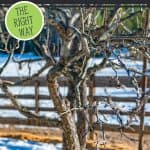









Annual pruning (the right way) is so important for the health of your fruit trees. It can lead to a long, healthy and productive life for your trees and will increase the yield and quality of your fruit.

After a long winter on the homestead, we’re excited to put our wintertime rhythms behind us and take advantage of longer days and more sunshine.
Planning your spring garden BEFORE you plant, knowing these 5 tips to have your BEST garden season ever, and knowing the best steps to prepare your garden for winter are all helpful to set you up right for the gardening season.
In the same way, knowing a few things about pruning your fruit trees is extremely beneficial when you get that first sunny spring day and want to tackle all those unruly branches.
We don’t recommend taking your sheers and just guessing when it comes to trimming branches, but with the following tips, you should be well on your way to a healthier tree and more fruitful harvest.
Why should you prune fruit trees?
- Control the size – Pruning fruit trees helps to control the size of the tree. Keeping the size of the tree at a manageable level can be advantageous so all the fruit can be reached to be picked.
- Renew fruiting wood – When you prune a tree you’re helping to stimulate the growth of new fruiting wood. This fruiting wood is the wood that create more fruit spurs and will bear fruit. A neglected tree will eventually have much more non-fruit producing deadwood.
- Access – We want to be able to get into the tree to pick the fruit for ease of pruning each following year. It’s also helpful to have easy access if an organic spray is needed for any reason.
- Different goals – It’s important to know your goals before pruning so you know which method to follow. It may be an option to not prune your trees at all if the quality and quantity of fruit isn’t in your main goal.

Do all fruit trees need to be pruned?
In short, IT DEPENDS!
This is a tricky question because it really depends on your goals for the tree, how old the tree is, and how much you want to manage the tree in years to come.
Sepp Holzer in Austria has chosen to not prune his trees at all. He found in his studies that if you prune a tree you will ALWAYS need to prune a tree. But if you let a tree grow naturally, it will grow up and not get unruly or become a tangled mess.
If you want a low maintenance tree and the production that comes out of the tree isn’t your main goal, then you can just let the tree obtain its natural form.
Benefits of Pruning Fruit Trees
- Maximize the harvest – By pruning your fruit tree you will stimulate the growth of new, fruit-bearing wood.
- Control the growth – You will be able to control the direction of the new growth, allowing for maximum harvest, sunlight and airflow.
- Allow sunlight into the tree – If your tree becomes overgrown and unruly, the sunlight won’t be able to penetrate the lower branches. Over time these branches will stop producing and become deadwood. The fruit will then be at the top of the tree and much harder to harvest.
- Allow for proper airflow – You want to allow proper airflow into the fruit tree as well. For a productive tree, each fruit-bearing branch needs to have adequate airflow to grow nice and strong.

What tools do you need for pruning?
You really want to use the right tool when pruning trees. If you’re grabbing the wrong tools you can do some minor damage to the tree bark, which really isn’t ideal. Here are our recommendations:
- Secateurs – The most important tool is going to be a nice sharp pair of secateurs (or “nippers” as we call them). These will be what you use for shaping and cutting off anything that is 3/4 inch in diameter and smaller.
- Folding pocket saw – One of our favorite garden tools is Opinel knives. We’ve used them for 25 years and they’re a great quality tool. This pocket saw will be handy for sawing off any deadwood or branches that are about 1 inch in diameter.
- Loppers – These can be used on branches that are about 1 inch in diameter up to 2-3 inches (or whatever your strength can get through). Something to consider about using loppers is it will pinch the bark where the cut is and can cause some tearing.
- Silky Saw – This saw is great for branches that are about two inches in diameter or larger.
- Pole saw – If you’re working with a larger tree and don’t want to get up on a ladder, then a pole saw can come in handy.
- Chain saw – A chainsaw might be needed for older trees that really need some rehab, but more than likely, a Silky or pole saw should work just fine. We like to use a chainsaw to rough out the shape of a tree that’s been neglected for many years.
- A ladder – If your tree has grown up very tall, it’s likely you’ll want to have a ladder to get up to the top of the tree.

How to Prune Fruit Trees
To see a tree being pruned and to have a visual of proper cutting techniques, watch the video above. Don’t feel like you have to get the tree perfect in one year, it usually takes a few years’ time to get the ideal results.
Typically speaking, for older overgrown trees you’ll want to follow this basic three-step process:
- Get rid of anything that’s dead to get it out of the way.
- Get rid of the understory, any branches that aren’t getting light, aren’t producing and are using up energy.
- Get rid of any crossover branches to allow for more light and air.
You want to take care not to cut more than about 1/3 of the tree off in a year. When making your cuts, you want to cut the branch off right at the branch collar for a flush cut. This will allow the tree to heal the wound.
You don’t want to cut below the collar, because then the tree won’t be able to heal. And you don’t want to leave a stub, because this will eventually rot and introduce disease to a tree. (Watch the video above for an example of what this looks like.)

When to Prune Fruit Trees
Old-timers would say, “When the knife is sharp and when you have the time”.
There are reasons for pruning trees at different times of the year. Again, this all boils down to your goals and your abilities.
If your goal is to have a beautiful and productive fruit tree, then you’ll want to stick to pruning the tree when it’s dormant, with possibly a few touch-ups in the late spring and summer.
If you’re not really concerned about the fruit production of the tree, then you’ll have more leniency on when to prune.
And finally, if you want the tree to take on its natural form, then not pruning at all is certainly an option.
If you’ve had consistent problems with disease, then you’ll want to take more precautions when pruning and stick to late winter, early spring pruning when the tree is still dormant and the temperature is cooperative.
Pruning Fruit Trees in the Summer
If you prune a tree during the summertime, the tree has already used up its energy to grow the new wood, so if you cut it off during the summer, it will slow down the tree’s growth.
Again, it comes down to picking the best strategies for your own goals.
If you’re not dealing with chronic disease issues or environmental issues, then you can prune at different times of the year.
You can even do a SECOND pruning in the summer if you’ve already pruned in the winter or spring. Once you see how the new growth of your tree is coming in if you come back and re-evaluate the tree you can make some additional cuts at that time.
For example, if you missed some deadwood that’s not producing any new growth you can cut it off. Or if you notice a branch that’s grown out and is crowding some other branches, cut it off.
As we mentioned above, as long as you’re not dealing with any chronic diseases, you will be just fine pruning in the summer.
Pruning Fruit Trees in the Fall
You can prune your trees in the fall, once fruit production has completed, and this will allow you to get a bit of a headstart for the next year. However, there’s no real benefit to pruning in the fall, other than if that’s when it fits best into your schedule.
Ideally, if your goal is high-quality fruit production, you want the tree to be in its dormant state when you prune so that all the trees energy goes into producing new wood.
Pruning Fruit Trees in the Winter
Dormant pruning (late winter, early spring), which is before the buds start to swell and after the sub-zero temperatures. If you prune when you might have some sub-zero freezing temperatures, you may have some damage to the wounds.
If you prune a tree during its dormant state, you’re going to force the growth of the tree once it becomes active in the spring.
Pruning Fruit Trees in the Spring
Pruning trees in the spring is just fine, and in our case, the ideal time because the threat of really cold weather is behind us, but it’s still cold enough that the buds on the trees haven’t swollen.

What should a properly pruned fruit tree look like?
Before you begin pruning your tree, whether it’s a new sapling or an old, overgrown tree, you want to consider the scaffold or “skeletal structure” of the tree.
There are two types of tree structures, either open base shape or central leader (or modified central leader).
Each of these will typically have 3-5 main scaffold branches. You can think of these as the “bones” of your tree. They’re what all the other branches will come off of and will form the basic shape of your tree.
A properly pruned fruit tree will have branches that allow for light and air to penetrate the entire tree, even to the lower branches.
You don’t want branches on your tree that are pointing into the center of the tree, these will be difficult to tend to and difficult for harvesting any fruit.
You also don’t want any “water sprouts” which are typically upright shoots that develop from dormant buds on the trunk or scaffold branches. Oftentimes, the pruning or removal of larger branches will stimulate dormant buds to grow.
Watch the video above for more tips on how to clean up a mature fruit tree.

Are different fruit trees pruned differently?
Fruit trees are all pruned very similarly, following the same basic principles, however, you’ll want to prune different fruit trees at different times of the year.
Pear and apple trees will be pruned very similarly, ideally in the late winter, early spring before the buds have swollen, but after the threat of sub-zero temperatures.
Stone fruit should be pruned AFTER the trees flower because the tree is much dryer and the risk of introducing disease is much less.
If you have more questions…
For more information, or to reach out to Casimir Holeski, visit him on Facebook at Boundary County Restoration Project, I.M. Tree Crops, or Casimir Holeski.


















